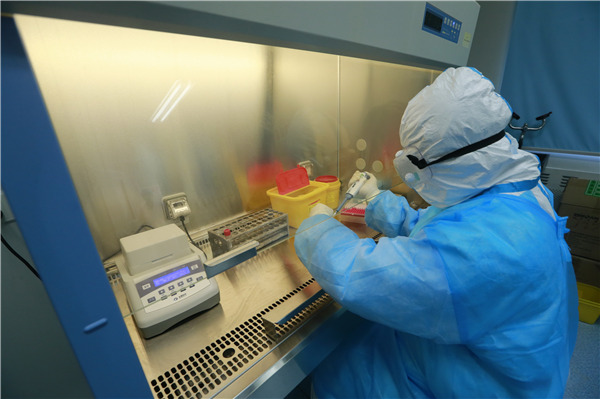 |
|
A lab worker extracts nucleic acid for detection and confirmation of the virus in the CDC of Suining, Sichuan province, on Wednesday. [Photo/Xinhua] |
Nucleic acid detection has been the most important method to screen the latent virus in the body of a patient since the outbreak, but it was not as easy as people thought.
Bu's first confirmation of the novel coronavirus pneumonia took six days. The first specimen was delivered to his lab on Jan 15, when they had no NCP detection reagent.
Bu and his colleagues ruled out all possibilities-ordinary flu, bird flu, SARS, MERS and respiratory syncytial virus. They sent the specimen to the provincial center for disease control and prevention the next day for an NCP detection, and again it was negative.
They continued the tests with two kinds of reagents and three methods to extract nucleic acid, and the specimen finally tested positive for NCP in the early hours of Jan 22. It was the first confirmed case of the novel coronavirus in Fuyang.
The workflow of a nucleic acid detector is highly risky. They have to open the cap to culture the virus by mixing the cells with nutrients in a big jar and swirling it around, during which a large quantity of aerosols that are extremely contagious will be generated.
"To be honest, I thought the epidemic was still faraway until I began detecting nucleic acid myself. When I'm working, I can really feel how tight the fight against the virus is," says Bu.
"To confirm each case requires at least three nucleic acid tests, so their workload is very heavy, and they must concentrate as the number of suspected cases keeps going up," says Hu Yunkai, director of Fuyang's CDC.
Meng Zhaoqian, Bu's wife and colleague, rubs the bridge of her nose and her cheekbones after taking off her gown. "My face really hurts after wearing the goggles and masks for so long," she says. The two take turns to go home and rest to avoid cross-contamination.
As of Feb 8, the laboratory has tested nearly 800 samples and more are yet to come.